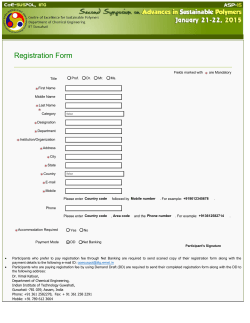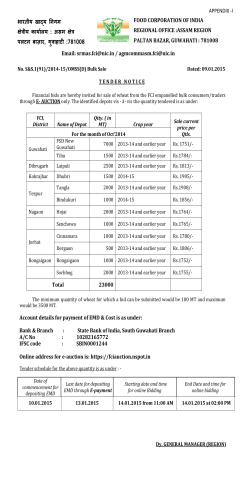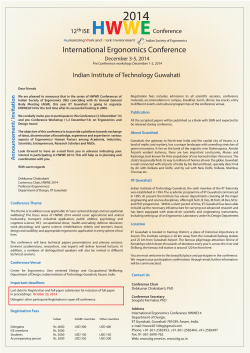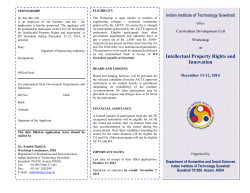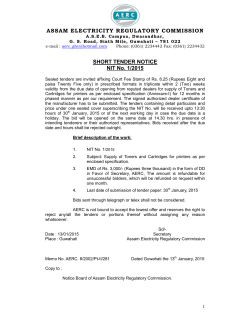
4 - Indian Institute of Technology Guwahati
ME 101: Engineering Mechanics A. Narayana Reddy Department of Mechanical Engineering, Indian Institute of Technology Guwahati, Guwahati - 781039, India. Sample free-body diagrams Lecture 4 A Narayana Reddy Indian Institute of Technology Guwahati 2 / 36 Sample free-body diagrams Lecture 4 A Narayana Reddy Indian Institute of Technology Guwahati 3 / 36 Complete the following free-body diagrams Lecture 4 A Narayana Reddy Indian Institute of Technology Guwahati 4 / 36 Complete the following free-body diagrams Lecture 4 A Narayana Reddy Indian Institute of Technology Guwahati 5 / 36 Complete the following free-body diagrams Lecture 4 A Narayana Reddy Indian Institute of Technology Guwahati 6 / 36 Complete the following free-body diagrams Lecture 4 A Narayana Reddy Indian Institute of Technology Guwahati 7 / 36 Draw the free-body diagrams (b) (a) (d) (c) Lecture 4 A Narayana Reddy Indian Institute of Technology Guwahati 8 / 36 Engineering structures Engineering structures are made of several connected memebrs. The members are assumed to be rigid bodies in this discussion. There is force applied by one member on another and vice versa if the two members are interconnected. Newton’s third law states that forces of action and reaction between two connecting bodies must have same magnitude, line of action, and opposite in direction. Engineering structures are classified into three categories. Trusses - Contain all two-force members. Frames - Contain at least one multi-force member. Machines - Strcure contain moving parts and used for transmit the motion and also to modify forces. Lecture 4 A Narayana Reddy Indian Institute of Technology Guwahati 9 / 36 Definition of a truss A truss consists of straight members connected at joints. No member is continuous through a joint. Bolted, riveted, or welded connections are assumed to be pinned together. Force acting at the member reduce to a single force and no couple. Only two-force members are considered. The forces are applied only at the joints. When forces tend to pull the member apart, it is in tension. When the forces tend to compress the member, it is in compression. Plane truss - Members lie in a single plane. Lecture 4 A Narayana Reddy Indian Institute of Technology Guwahati 10 / 36 Definition of a truss Lecture 4 A Narayana Reddy Indian Institute of Technology Guwahati 11 / 36 Applications of trusses Lecture 4 A Narayana Reddy Indian Institute of Technology Guwahati 12 / 36 Simple trusses A rigid truss will not collapse under the application of a load. Basic element of plane truss is the triangle. The polygon formed by four or more bars is a nonrigid frame. Nonrigid frame can be made as a stable structure by adding extra memebrs. A simple truss is constructed by successively adding two members and one connection to the basic triangular truss. Lecture 4 A Narayana Reddy Indian Institute of Technology Guwahati 13 / 36 Analysis of Trusses If the truss is in equilibrium then the forces are in balance at every point on the truss and in particular at every joint. Method of joints Satisfying the equilibrium equations at every joint of truss. If the truss is in equilibrium then every part or segment is also in equilibrium. Method of sections The equilibrium is used for the part of truss. This is useful for getting force in a member of interest without solving all joints. Lecture 4 A Narayana Reddy Indian Institute of Technology Guwahati 14 / 36 Method of joints Lecture 4 A Narayana Reddy Indian Institute of Technology Guwahati 15 / 36 Example Lecture 4 A Narayana Reddy Indian Institute of Technology Guwahati 16 / 36 Example Lecture 4 A Narayana Reddy Indian Institute of Technology Guwahati 17 / 36 Example Lecture 4 A Narayana Reddy Indian Institute of Technology Guwahati 18 / 36 Example Lecture 4 A Narayana Reddy Indian Institute of Technology Guwahati 19 / 36 Example Lecture 4 A Narayana Reddy Indian Institute of Technology Guwahati 20 / 36 Joints under special loading conditions Lecture 4 A Narayana Reddy Indian Institute of Technology Guwahati 21 / 36 Statically indeterminate truss Statically indeterminate truss External redudancy Internal redundancy External redundancy: Lecture 4 A Narayana Reddy Indian Institute of Technology Guwahati 22 / 36 Internal redundancy Internal redundancy The members in a truss is more than that are required to maintain the equilibrium. This is also known as degree of internal indeterminacy. Let n be number of joints in a given truss. Let m be number of members in a given truss. Therefore, we can form 2n equations as force is balanced at every joint along x and y direction. On the other hand, we have m + 3 unknowns as axial force in m members along with three reaction forces. Thus, the necessary condition for internal static determinacy is given by m + 3 = 2n. The Maxwell’s rule: m + 3 = 2n. → statically determinate internally m + 3 > 2n. → statically indeterminate internally m + 3 < 2n. → unstable Lecture 4 A Narayana Reddy Indian Institute of Technology Guwahati 23 / 36 Internal redundancy The criterion m + 3 = 2n is necessary condition but not sufficient condition. In other words, if the truss is statically determinate internally then that must satisfy the criterion m + 3 = 2n. But all the structures that satisfy the condition m + 3 = 2n is not necessarily statically determinate internally. Lecture 4 A Narayana Reddy Indian Institute of Technology Guwahati 24 / 36 Necessity of redundancy Why to provide redundant members? To maintain allignment of two members during construction. To increase stability during construction. To prevent buckling of compressive members. To provide support if the direction of loding is changed. Redundant members can act as backup members if some members are failed during loading. Analysis of truss with redundant members is difficult but possible. Lecture 4 A Narayana Reddy Indian Institute of Technology Guwahati 25 / 36 Example Determine the force in members FH, GH and GI. Lecture 4 A Narayana Reddy Indian Institute of Technology Guwahati 26 / 36 Method of sections Caution The section of truss must be consider such that there are only three unknown force members are on the section as we have three equilibrium equations. Lecture 4 A Narayana Reddy Indian Institute of Technology Guwahati 27 / 36 Example Lecture 4 A Narayana Reddy Indian Institute of Technology Guwahati 28 / 36 Example Lecture 4 A Narayana Reddy Indian Institute of Technology Guwahati 29 / 36 Example Lecture 4 A Narayana Reddy Indian Institute of Technology Guwahati 30 / 36 Example Lecture 4 A Narayana Reddy Indian Institute of Technology Guwahati 31 / 36 Example Calculate the forces induced in members KL, CL, and CB by the 200 kN load on cantilever truss. Lecture 4 A Narayana Reddy Indian Institute of Technology Guwahati 32 / 36 Space trusses Lecture 4 A Narayana Reddy Indian Institute of Technology Guwahati 33 / 36 Space trusses Lecture 4 A Narayana Reddy Indian Institute of Technology Guwahati 34 / 36 Example Determine the forces acting in members of the space truss Solution: At joint A: Lecture 4 A Narayana Reddy Indian Institute of Technology Guwahati 35 / 36 Example At joint B: At joint C and D: Lecture 4 A Narayana Reddy Indian Institute of Technology Guwahati 36 / 36
© Copyright 2025
